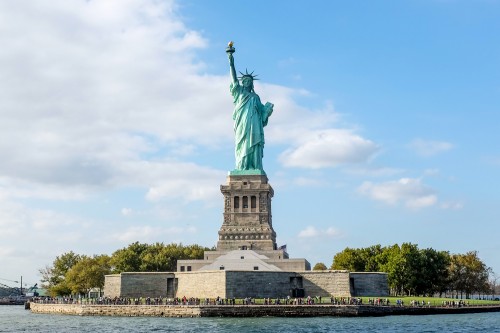From the Statue of Liberty in New York to the Tower of London - sea level rise not only affects populated areas in large parts of the world but also countless UNESCO World Heritage Sites.

Our viewers in a thousand or two thousand years will only be able to view the Statue of Liberty if they put on a diving suit. Some of the world's most recognizable and important symbols may fall victim to sea level rise if the global warming trend continues in the coming hundreds and thousands of years.
A study published March 5 in the journal Environmental Research Letters details a calculation of some of the 720 sites currently on the UNESCO World Heritage List that may be affected by sea level rise as a result of warming.
The Statue of Liberty, Independence Hall, the Citadel of London and the Sydney Opera House are among the 136 sites that may be affected if the current trend continues and the average temperature rises 3 degrees Celsius above pre-industrial temperatures in the next two thousand years. The scenario is not particularly extreme, the researchers say.
Other cities whose centers will sink under water are Bruges, Naples, Riga, St. Petersburg, Venice and its lagoon, the Air and Ben and the Westminster Abbey.
The lead researcher, Prof. Ben Marzion from the University of Innsbruck says: "The sea level is responding to global warming slowly but consistently due to a key process involved. The absorption of heat by the oceans and the melting of land ice will continue even after the warming of the atmosphere stops."
His research partner, Prof. Andre Levermann from the Institute for Climate Impact Research in Potsdam says: "After two thousand years, the oceans will reach a new state of equilibrium that will help us calculate the ice loss in Antarctica and Greenland in our physical models. At the same time, we consider two thousand years as a short enough time to be relevant to the cultural heritage we value."
The researchers calculated the percentage of inhabited areas that currently live below the expected future sea level in 2,000 years if average temperatures rise 3 degrees above the pre-industrial average.
They discovered that 7% of the total population lives on land that will be below sea level and that the distribution of this population is not uniform. Over 60% of it will live in China, India, Bangladesh, Vietnam and Indonesia.
In addition, the researchers calculated the percentage of the land area that would be under water in the same scenario. They found that seven countries including the Maldives, the Bahamas, and the Cayman Islands will lose 50% of their land area and another 35 countries will lose 10% of their land area.
Prof. Marzion concludes: "Our results show that if there is an increase of 3 degrees, even if it continues for two thousand years, which is a reasonable and not extreme scenario today, the impact on the heritage sites will be devastating.
"We started from the assumption that a heritage site will be damaged when its last part is below sea level, however tides and storms may dictate whether it will be possible to protect the site before the sea water reaches this point."
